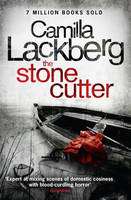The Stone Cutter
The Stonecutter (Swedish: Stenhuggaren) is a 2005 novel, a psychological thriller by Camilla Läckberg.[1] It was translated by Steven T. Murray in 2008.
 Hard Cover | |
| Series | Pegasus Crime |
|---|---|
| Subject | Popular Fiction-Contemporary Thrillers |
| Genre | Crime |
| Publisher | HarperCollins |
Publication date | 2005 |
Published in English | 2008 |
| Pages | 480 pages |
| ISBN | 0-00-730593-1 |
| Preceded by | The Preacher |
| Followed by | The Gallows Bird |
A parallel story concerns a stonecutter in the area in the 1920s who falls under the spell of his employer's daughter, Agnes.[2][3][4][5] This sub-plot regarding Anders' forbidden liaisons with his boss' spoiled daughter interweaves with a modern-day mystery.[6][7][8][9] Camilla delicately adjusts the disparate narrative features noose-like around her many analysed characters, her unique approach of revealing unexpected/sad truths about the residents in reverse dominates.[10]
Plot
Sara, an eight-year-old girl, is found in a fisherman's net.[11] The post-mortem shows that this was not a case of accidental drowning. Her death is no less shocking for Patrik Hedström having just become a father.[12] He and his partner Erica knew this child well, as she was the daughter of Erica's friend Charlotte, whom she bonded with as they both recently had children.[12][13] It is his task to discover who could be behind the murder.[14] What he does not know is how this case will reach into the blackened heart of Fjällbacka and the town's history, ripping apart its idyllic façade, perhaps permanently.[15] The parents of the dead child live with the maternal grandmother, Lilian, an acerbic hag engaged in a never-ending battle with her 'Neighbour from Hell' Kaj, who has built a new domicile next door to her profound chagrin; Kaj has a reclusive autistic son, Morgan, who spends many hours isolated in his room working on his computer; suspicions begins to point to him as the possible murderer, particularly as he had seen and spoken to the child on the day they died.[7]
Themes and commentary
A more claustrophobic narrative landscape than before; the plot consists of a shift between the past and the present-day account of the murder investigation, but the link twixt the alternating narratives is not revealed until the end: there are also multiple side stories which make for a somewhat cluttered plot.[16] The roots of the theme lie in an earlier generation and can be attributed, at least in part, to the upbringing of offspring. In the present, Erica and Patrik try to find a suitable parenting means; even the incompetent police chief becomes obliquely involved in raising an infant, albeit belatedly.[17]
References
- "", Publication Date: 4/7/2008
- http://www.camillalackberg.com/stenhuggaren
- Reader, Avid. "The Stonecutter Camilla Lackberg - Book Reviews of the Best Books".
- "Review - The Stonecutter by Camilla Lackberg". www.eurocrime.co.uk.
- http://blog.roodo.com/michelle_represent/archives/6719377.html
- http://sognisorrisi.blogspot.com/2010/06/book-of-week-stonecutter.html
- "The Stone Cutter - Camilla Lackberg". Random Jottings.
- "The Stonecutter by Camilla Läckberg - Paperback - HarperCollins". HarperCollins UK.
- Forshaw, Barry (22 March 2010). "The Stone Cutter, By Camilla Läckberg". The Independent. London.
- fishpond.com ["camillareview".]Titles/68889
- harpercollins ["timelessbooks".]Titles/62600
- "The Stonecutter by Camilla Lackberg".
- Noble, Barnes &. "The Stonecutter (Fjällbacka Series #3)-Audiobook". Barnes & Noble.
- "Review: The Stonecutter by Camilla Lackberg". Reactions to Reading. 2 August 2011. Archived from the original on 8 September 2011.
- "Not Found · Readings.com.au". www.readings.com.au.
- swedencrime.com ["camilla-write".]literature/65476
- librarything ["stonecutterreview".]Fjallbacka/62889